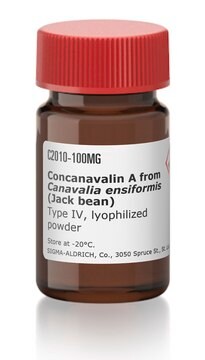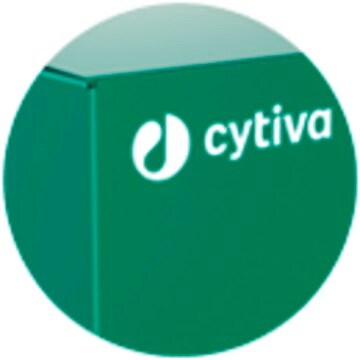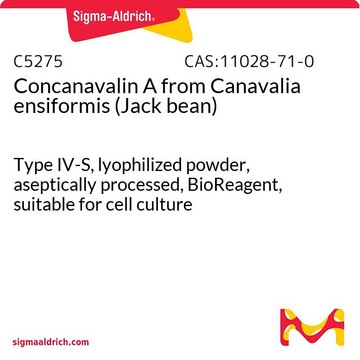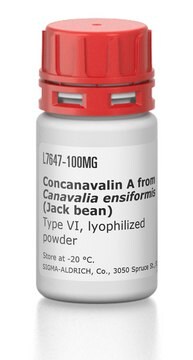C9017
Concanavalin A aus Canavalia ensiformis (Jack bean)
Sepharose™ conjugate, buffered aqueous suspension
Synonym(e):
ConA
Anmeldenzur Ansicht organisationsspezifischer und vertraglich vereinbarter Preise
Alle Fotos(1)
About This Item
UNSPSC-Code:
12161501
NACRES:
NA.32
Empfohlene Produkte
Biologische Quelle
Canavalia ensiformis
Konjugat
Sepharose™ conjugate
Form
buffered aqueous suspension
Enthält
20% ethanol as preservative
Kennzeichnungsgrad
10-16 mg per mL
Matrix
Sepharose 4B
Matrixaktivierung
cyanogen bromide
Matrixanbindung
amino
Matrix-Spacer
1 atom
Kapazität
≥25 mg/mL binding capacity (thyroglobulin)
Lagertemp.
2-8°C
Suchen Sie nach ähnlichen Produkten? Aufrufen Leitfaden zum Produktvergleich
Anwendung
Zur Aufreinigung von Glykoproteinen, die Mannose enthalten.
Biochem./physiol. Wirkung
Con A ist nicht blutgruppenspezifisch, hat aber eine Affinität für terminale α-D-Mannosyl- und α-D-Glucosylreste. Für ihre Aktivität sind Ca2+- und Mn2+-Ionen erforderlich. Bei einem pH-Wert von unter 5,6 löst Con A sich zu Dimeren auf. Bei einem pH-Wert von 5,8 bis 7,0 liegt Con A als Tetramer vor; bei einem pH-Wert über 7,0 bilden sich Aggregate. Con A weist eine mitogene Aktivität auf, die vom Ausmaß der Aggregation abhängt. Succinylierung führt zu einer aktiven dimeren Form, welche bei einem pH-Wert von mehr als 5,6 ihre Form beibehält.
Physikalische Form
Suspension in 0,1 M Acetatpuffer, pH-Wert 6,0, mit 1 M NaCl und 1 mM jeweils von CaCl2, MgCl2 und MnCl2
Hinweis zur Analyse
Falls angegeben, wird die Agglutinationsaktivität in μg/ml ausgedrückt und durch Serienverdünnungen einer phosphatgepufferten 1-mg/ml-Kochsalzlösung mit einem pH-Wert von 6,8, welche Ca2+ und Mn2+ enthält, bestimmt. Diese Aktivität ist die niedrigste Konzentration, bei der eine 2 % Humanerythrozytensuspension nach einstündiger Inkubation bei 25 °C agglutiniert.
Rechtliche Hinweise
Sepharose is a trademark of Cytiva
Ähnliches Produkt
Produkt-Nr.
Beschreibung
Preisangaben
Signalwort
Danger
H-Sätze
Gefahreneinstufungen
Repr. 2 - Resp. Sens. 1 - Skin Sens. 1
Lagerklassenschlüssel
3 - Flammable liquids
WGK
WGK 3
Flammpunkt (°F)
102.2 °F
Flammpunkt (°C)
39 °C
Hier finden Sie alle aktuellen Versionen:
Besitzen Sie dieses Produkt bereits?
In der Dokumentenbibliothek finden Sie die Dokumentation zu den Produkten, die Sie kürzlich erworben haben.
Kunden haben sich ebenfalls angesehen
Jae-Uoong Shim et al.
Inflammation, 32(4), 211-217 (2009-05-06)
Cudrania tricuspidata is one of the most omnipresent traditional herbal drugs for anti-inflammation and anti-tumor. The purpose of the present study was to determine whether the CTB glycoprotein regulates the inflammatory reaction stimulated by bisphenol A (BPA) in human mast
Phil-Sun Oh et al.
Journal of cellular biochemistry, 109(1), 124-131 (2009-11-04)
This study investigated the inhibitory effect of a glycoprotein isolated from Cudrania tricuspidata Bureau (CTB glycoprotein) on di(2-ethylhexyl) phthalate (DEHP)-induced mast cell degranulation and related signaling cascade in RBL-2H3 cells. This experiment evaluated the intracellular Ca(2+) level, and the activities
Robert J Huber et al.
Matrix biology : journal of the International Society for Matrix Biology, 31(4), 271-280 (2012-03-07)
CyrA, an extracellular matrix (slime sheath), calmodulin (CaM)-binding protein in Dictyostelium discoideum, possesses four tandem EGF-like repeats in its C-terminus and is proteolytically cleaved during asexual development. A previous study reported the expression and localization of CyrA cleavage products CyrA-C45
Jin Lee et al.
Journal of cellular biochemistry, 112(2), 694-703 (2011-01-27)
Cadmium is one of the inflammation-related xenobiotics and has been regarded as a potent carcinogen. Gardenia jasminoides Ellis (GJE) has been used to cure inflammation in Korean folk medicine for a long time. The purpose of present study is the
Sei-Jung Lee et al.
Food and chemical toxicology : an international journal published for the British Industrial Biological Research Association, 87, 12-22 (2015-12-04)
This study was carried out to investigate the anti-inflammatory potentials of a 38 kDa glycoprotein isolated from Styrax japonica Siebold et al Zuccarini (SJSZ glycoprotein). We found that SJSZ glycoprotein has concentration-dependent scavenging activity against DPPH and hydroxyl radicals in the cell-free
Unser Team von Wissenschaftlern verfügt über Erfahrung in allen Forschungsbereichen einschließlich Life Science, Materialwissenschaften, chemischer Synthese, Chromatographie, Analytik und vielen mehr..
Setzen Sie sich mit dem technischen Dienst in Verbindung.










